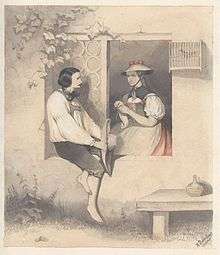Bollenhut



A Bollenhut is a formal headdress worn since about c.1750 by Protestant women as part of their local costume or Tracht in the three neighbouring Black Forest villages of Gutach, Kirnbach and Hornberg-Reichenbach. With its woollen pompoms, the picturesque-looking red Bollenhut has become a symbol of the Black Forest as a whole, despite its very local origins. The red pom-poms and white brim of the Bollenhut also is said to have inspired the top layer of the Black Forest Cake.[1]
Bollenhut as part of folk costume
The broad-brimmed, whitewashed straw hat bears 14 prominent, woollen, pompoms arranged in the shape of a cross. Only eleven pompoms are visible, however, because three are covered by those on top. Unmarried women wear red pompoms, married women wear black, old women and widows wear only the mob cap. The Bollenhut can weigh up to 2 kilogrammes and is manufactured by female milliners. The red Bollenhut may first be worn by girls at their confirmation.
A silk mob cap is worn underneath the Bollenhut, tied under the chin. Young girls before confirmation (Gutach and several neighbouring parishes were part of Württemberg until 1804 and were Protestant, unlike the majority of the Black Forest) and old women only wore the mob cap.
Today the Bollenhut and associated Tracht are still worn on holidays and for traditional events. The Bollenhut and local costumes may be seen all year round e.g. in the Black Forest Costume Museum in Haslach im Kinzigtal.
Development as a Black Forest symbol
In the late 18th century, apart from several mob caps, the Schühut and Gupfhut, which were customary in the County of Hauenstein, were associated with the Black Forest Tracht. These types of hats which were known Europe-wide gradually fell out of use by the middle of the 19th century. In 1841 following a study trip through the Black Forest, Théodore Valerio published, through the Fréres Gihaut in Paris, a lithograph of a couple from Hornberg wearing their local costume, which showed an early version of the Bollenhut for the first time in France. After Gutach was connected to the Baden Black Forest Railway in 1873, artists like Wilhelm Hasemann, Curt Liebich and Fritz Reiss settled there, forming the "Gutach artists' colony". They portrayed the Gutach costume as an artistic subject, their works were widely distributed and shaped the image of the Black Forest. Like local author, Heinrich Hansjakob, they were part of a movement of Baden folk costume. At the turn of the 20th century, particularly Hasemann's painting, After Going To Church which showed Bollenhut wearers, was widely publicized in illustrated magazines and picture postcards.[2]
The fame of the Bollenhut as (wrongly) generally typical of the Black Forest rose as a result of films of local life (Heimatfilme) in the 1950s and 1960s, particularly the 1950 film, The Black Forest Girl (Schwarzwaldmädel), with Sonja Ziemann. This first German colour film of the post war period is one of the most successful German films of all time with an estimated 15 million viewers.
References
- ↑ http://sweets.seriouseats.com/2014/01/know-your-sweets-black-forest-cake.html
- ↑ Brigitte Heck: Ein Hut macht Karriere.. In: Badisches Landesmuseum Karlsruhe (publ.): Baden! 900 Jahre – Geschichten eines Landes. Info-Verlag, Karlsruhe, 2012, ISBN 978-3-937345-56-7, p. 256 (Katalog zur Großen Landesausstellung)
External links
| Wikimedia Commons has media related to Bollenhut. |
| Look up Bollenhut in Wiktionary, the free dictionary. |